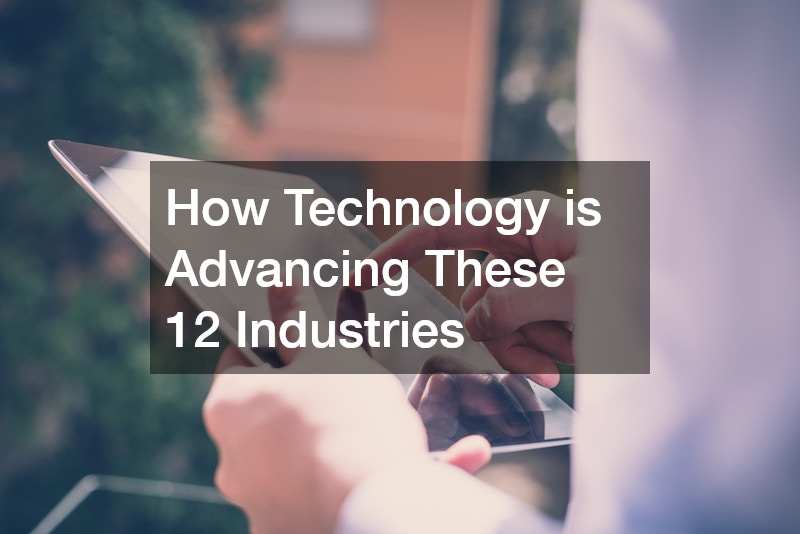In today’s fast-paced world, advanced innovation technology is transforming industries across the spectrum in ways that are both unprecedented and remarkable. From the way we travel to the manner in which we conduct medical research, technological advancements are reshaping traditional practices, driving efficiencies, and opening up new possibilities. In this comprehensive article, we will explore how technology is making a significant impact on 12 key industries. Join us as we delve into the ways in which advanced innovation technology is pioneering change, offering new solutions, and setting new standards across these diverse fields.
1. Commercial Driving
The commercial driving sector has seen remarkable changes with the incorporation of advanced innovation technology. Online CDL training platforms offer comprehensive and flexible educational resources for aspiring commercial drivers, enabling them to become proficient with ease. This tech-forward approach not only enhances the learning experience but also makes it more accessible to a broader audience.
Autonomous vehicles are another manifestation of technological progress in commercial driving. These vehicles are equipped with sensors, cameras, and intelligent software that allow them to navigate roads safely, reducing human error and increasing efficiency. This development not only transforms logistics by reducing delivery times and expenses but also emphasizes the importance of adopting new operational standards.
Intelligent transportation systems (ITS) are enhancing traffic management, providing real-time data that helps in route optimization and congestion minimization. By integrating advanced innovation technology, drivers and fleet managers can make informed decisions, streamline operations, and increase safety. These technological advances ensure the industry keeps pace with growing demands while maintaining a focus on environmental sustainability.
2. Chemical Industry
The chemical industry is witnessing a revolution, propelled by the integration of advanced innovation technology. The advent of artificial intelligence and digital modeling allows companies to predict molecular interactions, which accelerates product development cycles. This fosters innovation by enabling researchers to explore new compounds and formulations with greater precision.
Molecular sieves have become indispensable tools in chemical processes, thanks to their ability to selectively adsorb gases and liquids. These sieves are now produced with advanced manufacturing techniques that enhance their efficiency and durability. Their applications range from refining petroleum to preparing high-purity substances critical for pharmaceuticals, exemplifying how technology is optimizing industrial processes.
Automation and robotics are streamlining operations in chemical plants, reducing labor costs, and minimizing human exposure to hazardous environments. These technological advancements facilitate consistent quality control and higher throughput, resulting in increased productivity. By investing in advanced innovation technology, the chemical industry is poised to meet global demands while adhering to stringent environmental guidelines.

3. Rigging and Construction Safety
Advanced innovation technology is reshaping the rigging and construction safety sector, introducing new measures for worker protection and project efficiency. The development of stainless steel rigging hardware, for example, offers unparalleled strength and corrosion resistance, essential in maintaining the integrity of construction projects under various environmental conditions.
The adoption of digital modeling and simulation software has revolutionized the planning and execution of construction projects. These tools allow engineers to meticulously design structures, predict potential faults, and optimize material usage. The result is a safer and more economical approach to building that curtails waste and enhances performance.
Wearable technology is another key innovation, providing workers with real-time feedback on their physiological conditions and environmental exposures. These devices can alert wearers to potentially dangerous situations and provide data for enhancing workplace safety protocols. As the industry embraces these technological advancements, it sets a precedent for safer, more efficient construction practices worldwide.
4. Medical Industry
The medical industry is undergoing a transformative period, driven by the implementation of advanced innovation technology. Medical adhesives, for instance, have seen considerable improvements, offering better biocompatibility and durability, which are crucial for wound care and surgical applications. These enhancements ensure faster patient recovery times and reduced risk of complications.
Rare disease research is receiving unprecedented attention due to advancements in genomics and personalized medicine. Technologies such as CRISPR and next-generation sequencing enable researchers to study diseases at the molecular level and develop targeted therapies. This personalized approach enhances treatment efficacy and opens the door to curing previously untreatable conditions.
Telemedicine and artificial intelligence are redefining patient care by providing remote diagnosis and treatment, increasing healthcare accessibility. AI-driven analytics allows for early disease detection and better patient outcome predictions. By harnessing advanced innovation technology, the medical industry is not only improving care but also empowering patients through informed, personalized healthcare decisions.
5. Home Improvement
The home improvement sector is experiencing a surge of evolution with the integration of advanced innovation technology. Smart home devices, such as automated lighting and climate control systems, allow homeowners to manage their environments with unprecedented precision and convenience. These systems contribute to energy savings and enhance the overall living experience.
The role of gutters in home maintenance has also been revolutionized with the advent of advanced materials and designs that offer enhanced durability and efficiency in water management. These improvements reduce maintenance efforts and protect homes from water damage. Additionally, technologies that facilitate the seamless integration of such systems highlight the ongoing innovations in residential construction.
Custom garage builders are leveraging technology to offer unique, personalized solutions that cater to specific homeowner needs. From optimized storage solutions to energy-efficient lighting and security systems, modern garages are becoming multifunctional spaces. As the industry adopts these advanced innovation technologies, it not only improves functionality but also raises property values and homeowner satisfaction.

6. Weight Loss
Advanced innovation technology is significantly altering the landscape of the weight loss industry by providing personalized and effective solutions. Wearable fitness technology tracks physical activity, caloric intake, and vital statistics, offering users tailored insights for better health management. These tools enhance individual engagement and accountability in weight loss journeys.
Mobile applications and platforms designed for weight management deliver comprehensive programs encompassing diet plans, exercise regimens, and progress tracking. These digital solutions offer convenience and adaptability, making them a preferred choice for individuals seeking structured yet flexible weight loss strategies. The availability of expert guidance and community support through these platforms adds a valuable dimension to the process.
The application of AI in developing personalized dietary and fitness plans based on genetic and metabolic profiling is at the forefront of modern weight loss programs. Such technology offers insights into how individual bodies respond to various diets and exercises, allowing for more effective, sustainable interventions. The intersection of advanced innovation technology and health science is setting new standards in achieving and maintaining healthy lifestyles.
7. Dental Care
In the realm of dental care, advanced innovation technology is facilitating improved patient outcomes and streamlined clinical processes. Digital imaging and 3D printing have revolutionized the way dental professionals approach diagnosis and treatment planning, enabling more accurate and efficient care. Such tools enhance precision in procedures like orthodontic care, ensuring optimal alignment and bite correction.
Tele-dentistry has emerged as a vital component of modern dental care, providing remote consultations and diagnostics. This accessibility results in timely interventions and minimizes travel-related discomfort, a boon for patients in remote locations. The integration of AI in dental software is further enhancing diagnostics by analyzing imaging data to detect potential issues before they become problematic.
The development of new dental materials also underscores technological progress in this industry. Innovations in composites and dental ceramics provide longer-lasting, aesthetically pleasing results that mimic natural teeth convincingly. As these technologies continue to advance, dentists can offer treatments that are both minimally invasive and highly effective, paving the way for superior oral health outcomes.
8. Entertainment Industry
The entertainment industry is thriving on the back of advanced innovation technology, reshaping the way content is created and consumed. High-definition video production tools and virtual reality have enriched storytelling, offering audiences immersive experiences that were once thought impossible. These technologies elevate creative possibilities and set a new benchmark for engagement and interactivity.
Streaming platforms are a direct result of technological advancements, altering how audiences access films, shows, and music. They provide instant access to vast libraries of content, personalized recommendations, and flexibility unmatched by traditional media. Moreover, data analytics allows these platforms to cater to diverse preferences, reshaping market dynamics in favor of consumer choice.
The rise of user-generated content has also been facilitated by accessible video production tools, allowing aspiring creators to share their visions globally. Social media integration further amplifies reach and engagement, making the entertainment industry more inclusive and dynamic. These advances underscore the transformative role of technology in fostering creativity and democratizing media access.

9. Energy Sector
Advanced innovation technology is driving sweeping changes in the energy sector, promoting sustainability and efficiency. Renewable energy sources, such as solar and wind power, are gaining traction thanks to technological advancements that have reduced costs and improved storage capabilities. These innovations are not only decreasing reliance on fossil fuels but are also contributing to global carbon reduction efforts.
Smart grid technology is modernizing electricity distribution by enhancing grid resilience and incorporating renewable energies more effectively. This system enables dynamic management of energy consumption, aids in demand response efforts, and minimizes outages. Such advancements create a more reliable and environmentally friendly energy infrastructure.
The adoption of Internet of Things (IoT) devices in energy management allows for real-time monitoring and optimization of consumption across residential and industrial settings. These devices provide insights into energy use patterns, enabling individuals and businesses to reduce waste and lower costs. The role of advanced innovation technology in restructuring energy consumption reflects its critical importance in addressing modern environmental challenges.
10. Beauty Industry
The beauty industry is flourishing, propelled by the integration of advanced innovation technology that enhances product effectiveness and customer experience. AI-powered skincare analysis tools offer personalized recommendations based on unique skin profiles, elevating consumer satisfaction and loyalty. Such innovation facilitates a tailored approach to beauty, catering to individual needs like never before.
Virtual reality and augmented reality apps enable customers to try on makeup and hairstyles virtually, providing a risk-free method of experimentation. These technologies offer brands a platform to showcase products creatively while delivering unprecedented convenience to users, ultimately influencing purchase decisions.
Breakthroughs in cosmetic formulations, driven by genetic research and biotechnology, are creating products with enhanced efficacy and reduced allergens. Ingredients sourced from advanced biomimicry are inspiring skincare products that deliver potent results while being gentle on the skin. As technology continues to refine beauty practices, it brings a new era of empowerment to consumers and innovators alike.
11. Legal Practices
Advanced innovation technology is revolutionizing legal practices by streamlining operations and enhancing service delivery. Document automation software eliminates redundant tasks, allowing legal professionals to focus more on strategic elements rather than clerical work. This reduction in administrative burden translates to faster turnaround times and improved client satisfaction.
Artificial intelligence plays a pivotal role in legal research, where it sifts through vast databases to deliver relevant information quickly and accurately. This assists lawyers in case preparation and strategy development, providing a competitive edge and ensuring the application of the most pertinent legal precedents.
Virtual law offices and remote consultation platforms are paving the way for more flexible client interactions and accessibility, breaking down geographical constraints. These advancements not only keep legal practices relevant in the digital age but also meet the evolving expectations of clients seeking convenient and efficient service.

12. Real Estate
The real estate industry is embracing advanced innovation technology to transform how properties are marketed and managed. Virtual tours and augmented reality showings enable potential buyers to experience properties without the necessity of a physical visit, widening market reach and expediting the purchasing process.
Big data analytics aids in more informed property valuations and investment decisions by offering insights into market trends and consumer preferences. By utilizing this technology, real estate agents and investors can optimize strategies, enhancing profitability and reducing risks.
Smart home technology integration in new builds and renovations increases property value and appeal. Features like intelligent climate control, security systems, and energy-efficient appliances attract tech-savvy buyers who prioritize convenience and sustainability. This intersection of real estate and technology aligns with evolving consumer demands and future-oriented living solutions.
Key Takeaways
The influence of advanced innovation technology across these 12 industries is both profound and pervasive, underscoring the necessity for ongoing adaptation and continuous improvement. From online CDL training to the deployment of AI analytics in healthcare and legal sectors, the applications of technology are vast and varied, each contributing uniquely to the enhancement of industry operations and service delivery. This technological evolution offers a glimpse into a future where efficiency, personalization, and sustainability are paramount. Each industry, from commercial driving to real estate, leverages these developments to address contemporary challenges, harnessing the power of technology to foster growth and resilience. As we gaze ahead, the continued convergence of technology and industrial practices promises to unlock even greater potential, setting the stage for unparalleled progress and innovation across all sectors.
As industries continue to integrate advanced innovations, they not only redefine their internal processes but also reshuffle the broader economic landscape, impacting job markets and consumer behaviors globally. The adoption of technology propels industries into an era where human creativity and machine efficiency collaborate harmoniously, resulting in breakthroughs and advancements that once seemed out of reach. This ongoing transformation highlights the adaptability and potential for redesigning how industries operate, interact, and contribute to societal progress. Ultimately, the relentless pursuit of innovation will continue to shape industry trajectories, ushering in an era characterized by transformative breakthroughs that benefit industry stakeholders and communities at large.

